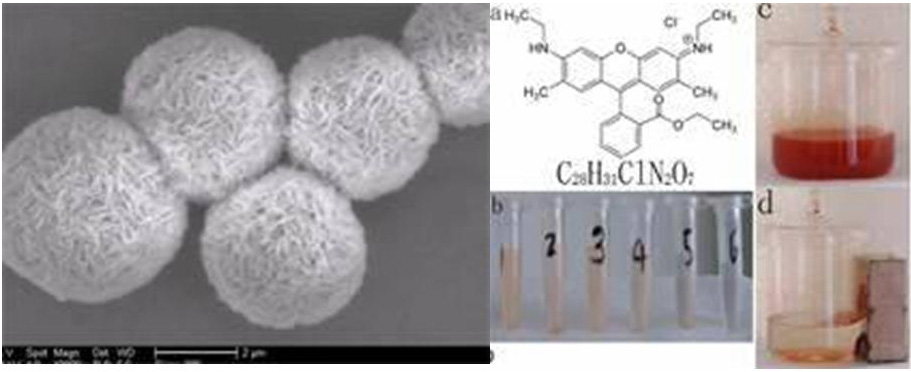At present, China is in a period of rapid economic growth. Along with the process of economic activities, environmental pollution is also increasing. For example, the discharge of a large number of chemical companies and the application of pesticides and fertilizers have caused serious pollution incidents and soil pollution in various places. The problem is becoming increasingly apparent, and the area of ​​soil pollution is increasing year by year. The general environmental pollution, whether it is lead, mercury in the air, or cadmium and arsenic in the sewage, after gradually precipitated, will eventually cause soil pollution. However, the scientific and technical workers have not yet found a restoration model that is economical, effective, and suitable for large-scale soil (field) treatment, and most of them are still in the laboratory exploration stage.
Researchers at the Nano Materials Laboratory of the Institute of Solid Physics, Institute of Material Science, Chinese Academy of Sciences have recently developed a series of nano-scale materials with strong adsorption, high specific surface area and high activity, and micro-scale materials that are resistant to agglomeration, easy separation and stable recycling New micro / nano structural materials with equal characteristics provide a new type of adsorbent and feed for the technology of reactive wall restoration of heavy metal contaminated soil.
This micro / nano structure material is a micro-scale structure material assembled by nano-scale units (such as nano-tubes, nano-sheets and nano particles, etc.) according to a certain rule, which maintains the high specific surface area of ​​nano-materials and strong adsorption characteristics. The advantages overcome the insufficiency of the nano-materials in unstable structure and easy agglomeration. Researchers obtained different micro / nano structural materials through the following methods:
One is based on the hydrothermal method of the structure inducer to obtain a series of new micro / nano structural materials. For example, a honeycomb spindle-shaped ZnO micro / nano structure material was synthesized using ethylenediamine directing agent (Adv. Funct. Mater. 2008, 18, 1047-1056), and a porous ZnO sheet micro / Nano structural materials (J. Mater. Chem., 2010, 20, 8582-8590) and so on.
Second, based on the template-erosion strategy, a series of micro / nano structure hollow spheres were synthesized. Such as: nickel silicate micro / nano structure hollow spheres, porous silicon oxide hollow spheres can be obtained under the treatment of acid solution, and a universal method of nickel / silica composite micro / nano structure hollow spheres can be obtained under reducing atmosphere (Langmuir, 2010, 26 (18), 14830-14834). Related series of achievements such as copper silicate and magnesium silicate were published in "Chemical Newsletter", "European Chemistry", "Nano Science and Technology" and "Nano Technology" and applied for related national invention patents.
Similarly, using metal / metal oxide core-shell structure microspheres as a template for weak acid etching, oxide hollow spheres can be obtained. Such as: Zn / ZnO core-shell structure microspheres, under the selective erosion of weak acids (such as tartaric acid), ZnO hollow spheres can be obtained; under the attack of weak acids containing metal ions, ZnO hollow spheres assembled with metal nanoparticles can be obtained; In the case of weak acid etching containing two metal ions, ZnO hollow spheres assembled with two metal nanoparticles can be obtained, and the relevant results are published in the American Chemical Society magazine ACS Nano (ACS Nano, 2008, 2 (8), 1661 -1670).
The third is to propose a new type of composite fiber based on the weak complex interaction between organic functional groups / metals. Using electrospinning technology, a series of organic / inorganic composite micro / nano-structured porous fibers were obtained. The relevant results were published in the British Chemical Society "Journal of Materials Chemistry" (J. Mater. Chem., DOI: 10.1039 / C0JM02334E).
The above-mentioned various micro / nano structural materials are suitable for engineering synthesis, and the conditions are mild, simple and controllable. They are suitable for use as adsorbent materials for reactive permeable walls and coating technology in the treatment of soil heavy metal pollution. These research results are targeted for the next step The treatment of persistent pollutants in the soil has laid a material foundation.

Photodegradation of Luo Danming 6G (R6G) under micro-nano structure porous Fe2O3 balls under visible light

Removal of Cr ions by PANFe (II) porous fiber with composite micro-nano structure synthesized by electrospinning technology
NINGBO CHEN WEI SUPPLY CHAIN MANAGEMENT CO.,LTD , https://www.nbchenweifurniture.com